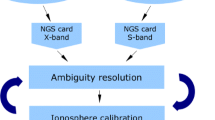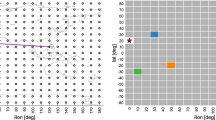Abstract
Very Long Baseline Interferometry (VLBI) Intensive sessions are scheduled to provide operational Universal Time (UT1) determinations with low latency. UT1 estimates obtained from these observations heavily depend on the model of the celestial pole motion used during data processing. However, even the most accurate precession- nutation model, IAU 2000/2006, is not accurate enough to realize the full potential of VLBI observations. To achieve the highest possible accuracy in UT1 estimates, a celestial pole offset (CPO), which is the difference between the actual and modelled precession-nutation angles, should be applied. Three CPO models are currently available for users. In this paper, these models have been tested and the differences between UT1 estimates obtained with those models are investigated. It has been shown that neglecting CPO modelling during VLBI UT1 Intensive processing causes systematic errors in UT1 series of up to 20 μas. It has been also found that using different CPO models causes the differences in UT1 estimates reaching 10 μas. Obtained results are applicable to the satellite data processing as well.
Similar content being viewed by others
References
Böckmann S, Artz T, Nothnagel A, Tesmer V (2010) J Geophys Res 115: B04404. doi:10.1029/2009JB006465
Hefty J, Gontier A-M (1997) Sensitivity of UT1 determined by single-baseline VLBI to atmospheric delay model, terrestrial and celestial reference frames. J Geod 71: 253–261
IERS Annual Report 2007 (2009) Verlag des Bundesamts für Kartographie und Geodäsie, Frankfurt am Main
Luzum B, Nothnagel A (2010) Improved UT1 predictions through low-latency VLBI observations. J Geod 84: 399–402. doi:10.1007/s00190-010-0372-8
Ma C, Arias EF, Bianco G, Boboltz DA, Bolotin SL, Charlot P, Engelhardt G, Fey AL, Gaume RA, Gontier A-M, Heinkelmann R, Jacobs CS, Kurdubov S, Lambert SB, Malkin ZM, Nothnagel AN, Petrov L, Skurikhina E, Sokolova JR, Souchay J, Sovers OJ, Tesmer V, Titov OA, Wang G, Zharov VE, Barache C, Böckmann S, Collioud A, Gipson JM, Gordon D, Lytvyn SO, MacMillan DS, Ojha R (2009) The Second Realization of the International Celestial Reference Frame by Very Long Baseline Interferometry In: Fey AL, Gordon D, Jacobs CS (eds) IERS Technical Note No. 35. Verlag des Bundesamts für Kartographie und Geodäsie, Frankfurt am Main
Malkin ZM (2007) Empiric models of the Earth’s free core nutation. Solar System Res 41: 492–497. doi:10.1134/S0038094607060044
Malkin Z (2009) On comparison of the Earth orientation parameters obtained from different VLBI networks and observing programs. J Geod 83: 547–556. doi:10.1007/s00190-008-0265-2
Malkin Z (2010) Analysis of the accuracy of prediction of the celestial pole motion. Astron Rep 54: 1053–1061. doi:10.1134/S1063772910110119
Nothnagel A, Schnell D (2008) The impact of errors in polar motion and nutation on UT1 determinations from VLBI Intensive observations. J Geod 82: 863–869. doi:10.1007/s00190-008-0212-2
Petit G, Luzum B (eds) (2010) IERS Conventions (2010), IERS Technical Note No. 36, Verlag des Bundesamts für Kartographie und Geodäsie, Frankfurt am Main
Robertson DS, Carter WE, Campbell J, Schuh H (1985) Daily Earth rotation determinations from IRIS very long baseline interferometry. Nature 316(6027): 424–427
Schlüter W, Behrend D (2007) The international VLBI service for geodesy and astrometry (IVS): current capabilities and future prospects. J Geod 81: 379–387. doi:10.1007/s00190-006-0131-z
Titov OA (2000) Influence of adopted nutation model on VLBI NEOS-intensives data analysis. In: Johnston KJ, McCarthy DD, Luzum BJ, Kaplan GH (eds) Proceedings of the IAU colloquium 180 “Towards models and constants for sub-microarcsecond astrometry”, March 2000, pp 259–262
Author information
Authors and Affiliations
Corresponding author
Rights and permissions
About this article
Cite this article
Malkin, Z. The impact of celestial pole offset modelling on VLBI UT1 intensive results. J Geod 85, 617–622 (2011). https://doi.org/10.1007/s00190-011-0468-9
Received:
Accepted:
Published:
Issue Date:
DOI: https://doi.org/10.1007/s00190-011-0468-9




